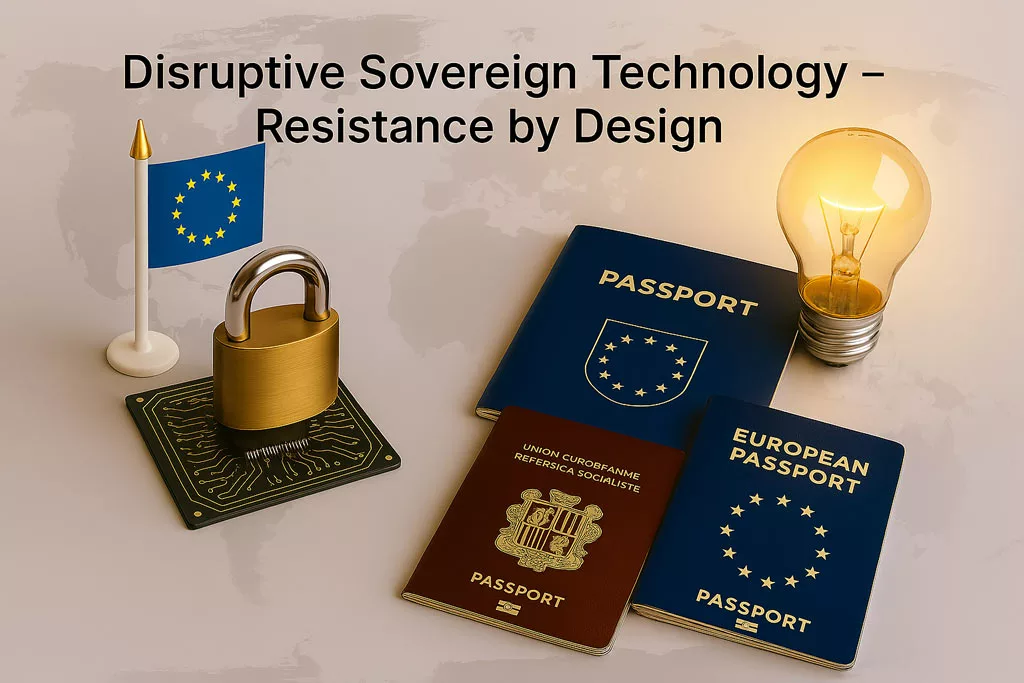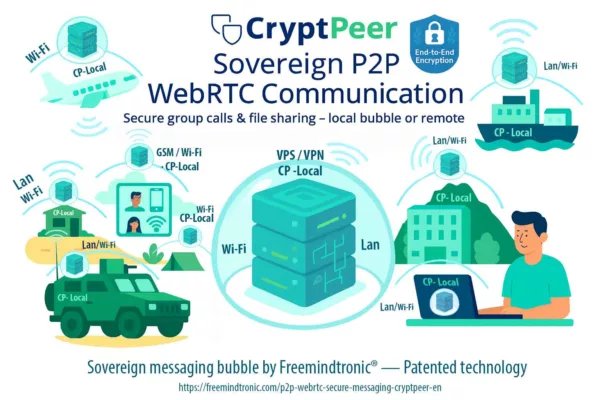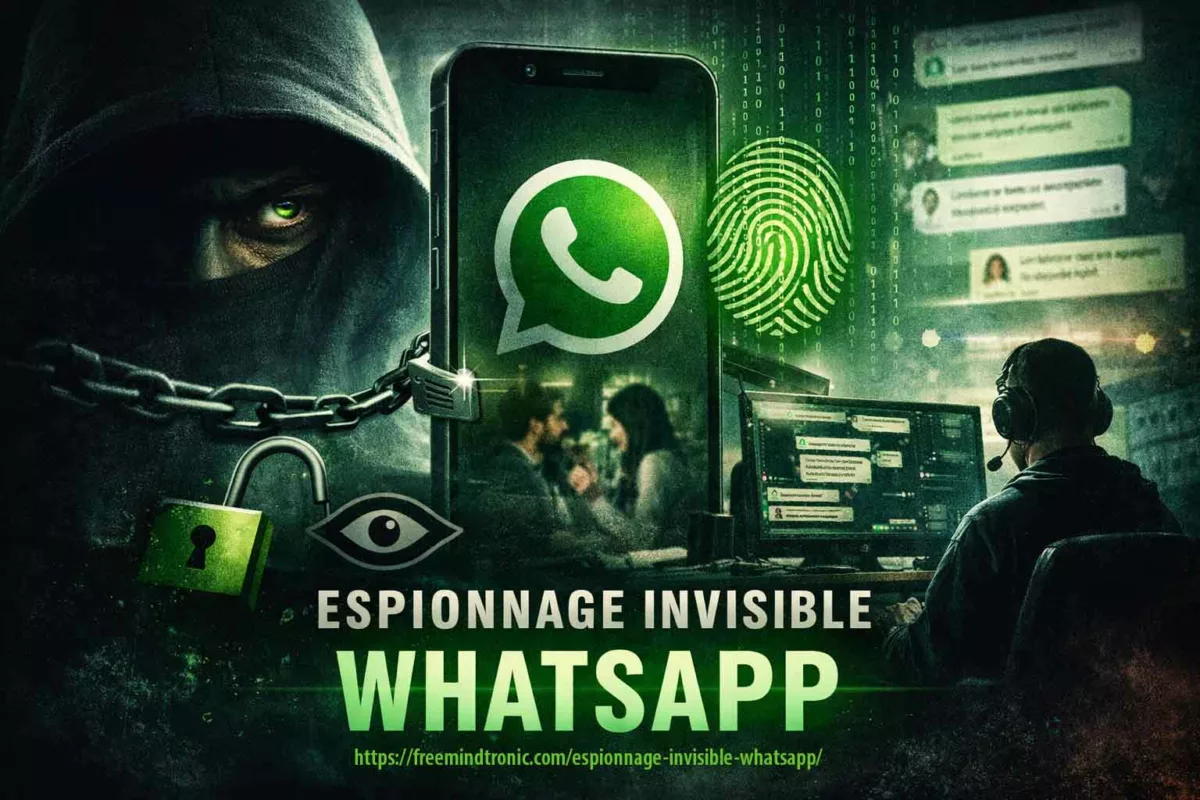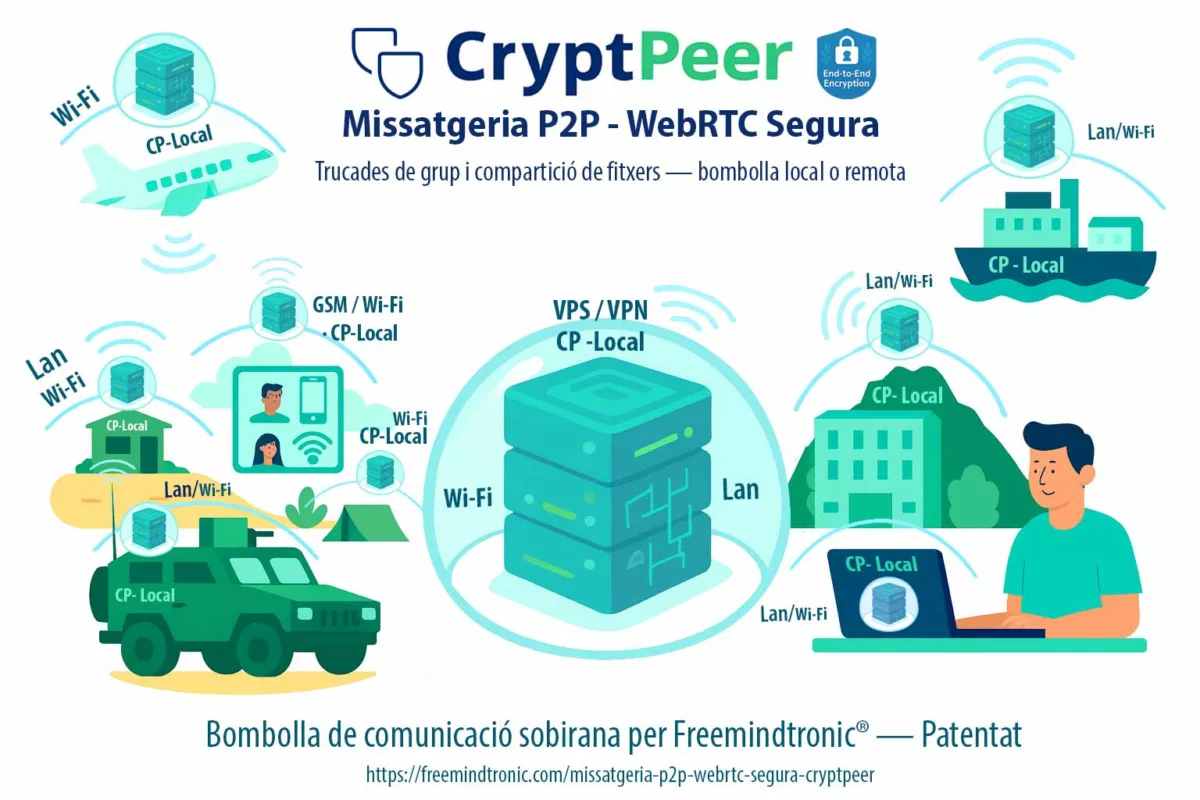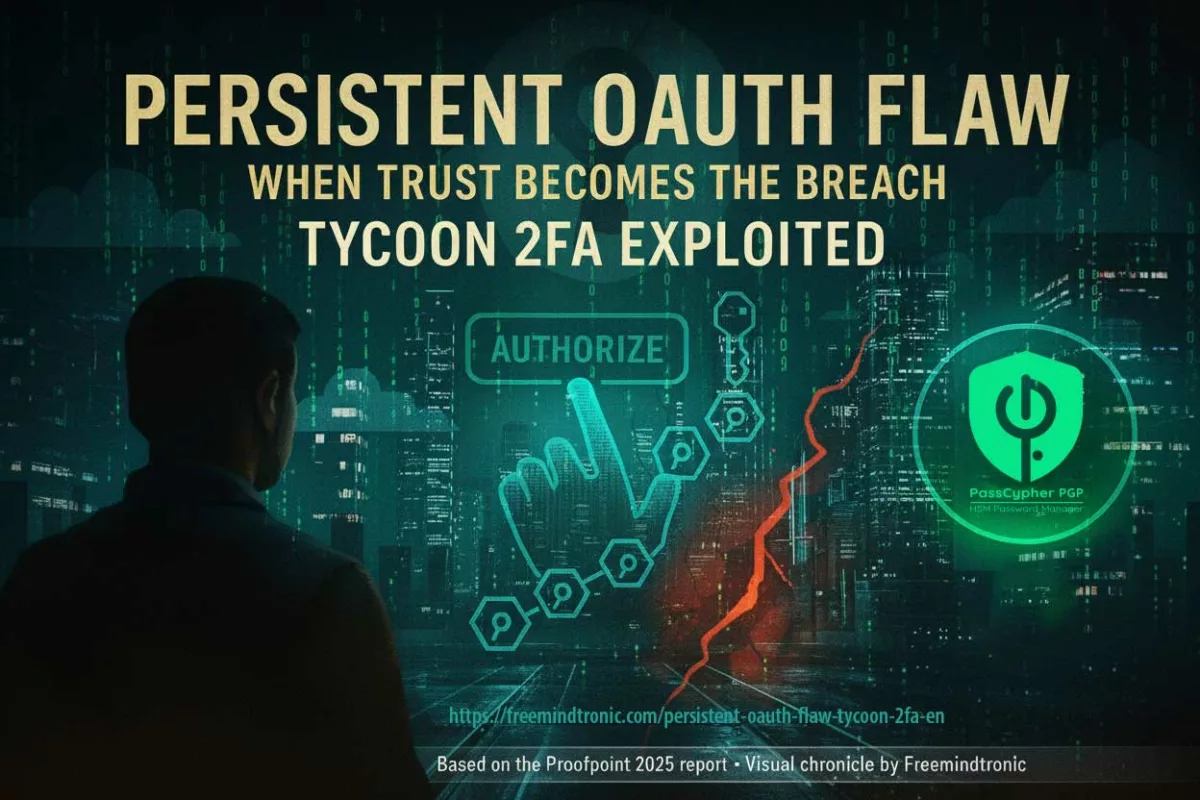Innovation of rupture is not simply a bold invention—it’s a shift in power, usage, and norms. This article explores two dominant visions of innovation, the role patents play in enabling or constraining breakthroughs, and the systemic resistance that disruptors must navigate. Using Freemindtronic’s sovereign cybersecurity technologies as a real-world case, we analyze how regulatory inertia, industrial dependencies, and biased standards affect the path to adoption. Anchored in field experience and strategic reflection, this narrative offers a vision of innovation that is resilient, disruptive, and sovereign by design.
About the author — Jacques Gascuel is the inventor and founder of Freemindtronic Andorra, where he pioneers disruptive sovereign cybersecurity technologies based on patented architectures. With a legal background and a strategic mindset, he explores how hardware-based security and normative resistance intersect in sovereign contexts. His work focuses on building autonomous systems — offline, OS-independent, and resilient by design — to address the systemic inertia in regulated environments. Through his publications, Jacques bridges field innovation, legal asymmetry, and technological sovereignty, offering a vision of cybersecurity that breaks compliance boundaries without compromising purpose.
Disruptive innovation doesn’t bloom from comfort. It emerges where certainties tremble—when new visions confront the inertia of accepted norms. In today’s strategic landscape, where sovereignty meets cybersecurity and systemic inertia blocks transformation, innovation of rupture becomes more than a buzzword. It’s a tension between evolving what exists and inventing what doesn’t. Many organizations believe innovation must adapt to existing frameworks. Others argue real progress demands defiance—crafting new usage models, new markets, and entirely new expectations. This friction fuels the deeper dilemma: should innovators conform to dominant systems or design alternatives that reshape the rules? In practice, innovation of rupture sits at this crossroads. It alters market structures, redefines user behaviors, and demands new regulatory thinking. But to disrupt effectively, it must challenge more than just technical limitations. It must shake habits, belief systems, and institutional dependencies. This article explores: While patents are commonly viewed as tools for safeguarding innovation, they rarely ensure its success. A patent may shield an idea from duplication, but it does not compel the market to embrace it. This tension is especially true for innovations of rupture, which often disrupt comfortable norms and threaten entrenched interests. Patents are legal instruments designed to grant inventors exclusive rights over their creations. They protect intellectual property, encourage investment, and often strengthen negotiation power. Yet, as powerful as patents are on paper, they do not automatically accelerate adoption. A patented disruptive technology may languish if it collides with regulatory inertia or lacks strategic alignment. 👉 According to the European Patent Office (EPO), over 50% of patents never make it to market. That figure increases when the technology challenges dominant standards or requires user behavior change. When disruption alters usage patterns or demands new norms, patents become part of a broader strategy—not a safety net. For instance, sovereign cybersecurity tools that operate without OS dependency or cloud access may bypass known frameworks entirely. In doing so, they risk clashing with legislation and standards designed around centralized control. 📌 Consider this: a patented sovereign security device offers offline encryption, no RAM exposure, and total independence. But if legal frameworks mandate auditability through centralized servers, the disruptive power becomes paradoxical—it’s secured by law yet suppressed by law. Innovation of rupture thrives only when the patent’s protection aligns with market readiness, user context, and communication strategy. Adoption requires more than exclusivity—it calls for trust, usability, and perceived legitimacy. The patent may block competitors, but only strategic narrative enables traction. As we move forward, it becomes clear that even well-protected inventions need to confront a larger force: systemic resistance driven by lobbying, standards, and industrial dependencies. Even the most visionary innovations are rarely welcomed with open arms. When a technology disrupts existing structures or threatens entrenched powers, it enters an ecosystem where resistance is embedded. Systemic forces—legislative inertia, industrial dependencies, and hidden lobbying—work collectively to defend the status quo. And this resistance doesn’t always wear a uniform. Sometimes it looks like compliance. Other times it’s masked as best practices. Standards are designed to harmonize markets, ensure safety, and guide interoperability. Yet in practice, some norms are shaped by dominant players to protect their advantage. When a disruptive technology operates outside conventional OS frameworks, centralized infrastructure, or cloud ecosystems, it may be deemed non-compliant—not because it is unsafe, but because it is independent. Strategic disobedience then becomes a necessity, not a weakness. The power of lobbying often lies in its subtlety. Through influence on advisory boards, standardization committees, or regulatory language, certain entities steer innovation in directions favorable to existing infrastructures. As reported in the OECD’s regulatory innovation framework, this type of resistance can stall sovereign solutions under the guise of safety, stability, or ecosystem integrity. Large-scale institutions—whether governmental, financial, or industrial—build upon legacy systems that are expensive to replace. Technologies that challenge those infrastructures often face delayed integration, skepticism, or exclusion. Sovereign cybersecurity tools, for instance, may offer superior decentralization, but if the ecosystem demands centralized logging or remote validation, their deployment becomes politically complex. In theory, disruptive innovation sparks transformation. In practice, it challenges conventions head-on. Freemindtronic’s sovereign cybersecurity solutions demonstrate what happens when disruption refuses to conform. Designed to operate fully offline, independent of operating systems or cloud infrastructure, these hybrid HSMs (Hardware Security Modules) embody true innovation of rupture. They don’t just secure — they redefine the terms of security itself. Freemindtronic’s DataShielder NFC HSM devices offer autonomous encryption, air-gapped by design. Credentials and cryptographic operations remain insulated from operating systems, RAM, and clipboard exposure — a direct response to threats like Atomic Stealer (AMOS), which weaponize native OS behaviors. This sovereign architecture decentralizes trust, eliminates third-party dependencies, and removes the attack surface exploited by memory-based malware. In a landscape where cybersecurity often means cloud integration and centralized monitoring, Freemindtronic’s solution is strategically disobedient. Despite its resilience and privacy-by-design principle, this type of sovereign hardware often encounters systemic resistance. Why? Because mainstream standards favor interoperability through centralized systems. Secure messaging protocols, compliance tools, and authentication flows assume OS/cloud integration. A device that deliberately avoids those channels may be seen as “non-compliant” — even when it’s demonstrably more secure. For Freemindtronic, rupture is not a side effect — it’s a strategic direction. By embedding sovereignty at the hardware level, the company redefines what cybersecurity means in hostile environments, mobility constraints, and regulatory asymmetry. Patents protect the technical methods. Field validation confirms operational effectiveness. But the real challenge lies in aligning this innovation with institutions still tethered to centralized control. Innovation of rupture offers strategic independence—but when used maliciously or without accountability, it can destabilize sovereign balance. Technologies designed for autonomy and security may become instruments of opacity, evasion, or even asymmetrical disruption. Furtive devices that bypass OS, cloud, and traceability protocols pose new ethical and political dilemmas. While sovereign tools empower users, they may also obstruct lawful oversight. This paradox reveals the fragility of digital sovereignty: the very features that protect against surveillance can be weaponized against institutions. If rupture becomes uncontrolled stealth, sovereignty turns inward—and may erode from within. State actors must balance innovation support with strategic safeguards. Furtive tech, if exploited by criminal networks or hostile entities, could bypass national defense, disrupt digital infrastructure, or undermine democratic mechanisms. The challenge is to maintain sovereignty without losing visibility. The answer is not to suppress rupture, but to govern its implications. Innovation must remain open—but the usage contexts must be anticipated, the risks modeled, and the countermeasures embedded. Otherwise, strategic disobedience may mutate into strategic evasion. In environments shaped by digital surveillance and institutional control, sovereign technologies must do more than protect — they must resist. Freemindtronic’s HSM architectures do not rely on operating systems, cloud, or centralized protocols. Their independence is not incidental — it is intentional. These devices stand as natural barriers against intrusion, espionage, and normative capture. By operating offline, memory-free, and protocol-neutral, these sovereign systems form natural countermeasures against technical espionage. At the institutional level, they resist interception, logging, and backend exploitation. At the individual level, they preserve digital autonomy, shield private credentials, and deny access vectors that compromise sovereignty. This architecture doesn’t just avoid surveillance — it actively denies the mechanisms that enable it. In doing so, it redefines the notion of defensive security: not as passive protection, but as active strategic disobedience. Sovereign HSMs like those from Freemindtronic don’t block threats — they render them inoperative. The CIA’s 2022 study on cyber deterrence recognizes that disruption of espionage pathways is more effective than traditional deterrence. Similarly, Columbia SIPA’s Cyber Disruptions Dataset catalogs how sovereign tech can neutralize even state-level surveillance strategies. Not all rupture starts by defying the frame. Sometimes, it emerges from strategic differentiation within existing norms. The Boxilumix® technology developed by Asclepios Tech exemplifies this pathway: it doesn’t reject post-harvest treatment—it reimagines it through light modulation, without chemicals. Boxilumix® respects regulatory frameworks yet achieves measurable innovation: longer shelf life, improved appearance, enhanced nutritional value. These advancements address stringent export demands and create value without entering regulatory conflict. Their approach earned high-level validation: Seal of Excellence (European Commission), Booster Agrotech (Business France), and multiple awards for sustainable food innovation. It proves that innovation of rupture can also arise from mastering differentiation, not just rebellion. Whether through institutional challenge or smart alignment, innovation succeeds when it balances context, purpose, and narrative. Asclepios Tech shows that rupture can be elegant, embodied through precision rather than force. Inventing is never enough. For innovation of rupture to matter, it must be adopted—and for adoption to happen, strategy must shape perception. Disruptive technologies don’t just fight technical inertia; they challenge political, cultural, and institutional expectations. Without a compelling narrative, even the most sovereign innovation remains marginal. Innovators often underestimate how tightly trust is bound to context. A sovereign security device may prove resilient in lab conditions, but if users, regulators, or institutions lack visibility into its methods or relevance, adoption slows. Disruption must speak the language of its environment—whether that’s national sovereignty, data protection, or resilience in critical infrastructure. A powerful narrative aligns the innovation with deeper social and institutional needs. It must translate disruption into clarity—not just for engineers, but for decision-makers, legal analysts, and end users. The message must express purpose, urgency, and credible differentiation. Long before markets shift, minds must be convinced. Creating new usage is more strategic than improving old ones. Sovereign cybersecurity tools succeed when they’re not just better, but necessary. Frictionless integration, context-aware functions, and layered utility drive usage organically. Once a tool shapes how people behave, it reshapes how industries and institutions respond. To thrive amid systemic blockers, innovators must anticipate regulatory gaps, industrial dependencies, and political asymmetries. Strategic rupture doesn’t mean isolation—it requires calibrated tension. By preparing answers to compliance queries, forging alternative trust models, and demonstrating social impact, the innovator positions disruption not as rebellion but as solution. Far from being speculative, the concept of innovation of rupture and technological sovereignty is increasingly echoed in global institutional and academic discourse. Recent studies expose how lobbying, standardization politics, and intellectual property systems can hinder strategic adoption. The need for independent frameworks, sovereign infrastructures, and regulatory agility is no longer just theoretical—it’s an emerging priority. The OECD report “Lobbying in the 21st Century” (2021) reveals how influential actors shape regulatory norms to sustain dominant business models. This aligns with our earlier analysis: disruption often faces resistance dressed as “standards.” Transparency International’s statement on OECD lobbying reforms warns of “unregulated influence ecosystems” that may suppress sovereign technologies before public adoption begins. The German institute Fraunhofer ISI defines technological sovereignty as the capacity to “make independent technological choices” in strategically sensitive domains. Their report underscores the role of rupture in escaping dependency traps — especially in digital infrastructure. Dutch research center TNO’s whitepaper details how decentralized, sovereign cybersecurity tools strengthen resilience. Offline hardware models — as exemplified by Freemindtronic — are cited as viable alternatives to cloud-based dependencies. The Stockholm School of Economics provides a detailed thesis on patent limitations: “The Impact of the Patent System on Innovation” by Julian Boulanger explains how patents fail when they lack socio-regulatory traction. Further, Télécom ParisTech’s thesis by Serge Pajak “La propriété intellectuelle et l’innovation” explores how innovation of rupture faces challenges when legal frameworks are not strategically aligned. An EU-wide study by Frontiers in Political Science “Digital Sovereignty and Strategic Autonomy” analyzes conflicts between national interest and imposed technical standards. It confirms what field innovators already know: real sovereignty often requires navigating beneath the surface of compatibility and compliance. The vision behind innovation of rupture is not isolated—it is increasingly echoed across high-level institutions, deeptech policy reports, and academic research. Sovereignty, disobedience by design, and resistance to normative capture are themes gaining traction in both state-level and multilateral contexts. Below is a curated set of official studies, whitepapers, and theses that lend credibility and depth to the disruptive sovereignty framework. The OECD’s report “Lobbying in the 21st Century” highlights how technical standards and regulatory influence are often shaped to favor incumbents. Norms may reflect ecosystem biases, not innovation potential. Transparency International further warns that unregulated influence ecosystems suppress sovereign technologies under the guise of compliance. Fraunhofer Institute’s 2021 paper frames sovereignty as the ability to make independent choices in tech-critical areas. It recognizes rupture as a mechanism to escape dependency traps and enhance strategic autonomy. The Dutch innovation hub TNO lays out clear alternatives to cloud-centric security in its 2024 whitepaper “Cybersecurity and Digital Sovereignty”. It cites air-gapped HSMs as foundational elements of resilience—a core tenet of Freemindtronic’s technology. The DGE’s Deeptech 2025 report defines innovation of rupture as a strategic lever to address industrial sovereignty, cybersecurity, and supply chain independence. It calls for regulatory flexibility and intellectual property reforms to enable adoption. In Springer’s 2024 monograph “Cyber Sovereignty”, researchers analyze how digital sovereignty is used by nations to reassert control in fragmented and unregulated technological ecosystems. It positions rupture as both political and technical strategy. Frontiers in Political Science explores the friction between pan-European norms and national digital autonomy. It validates sovereign hardware and non-cloud infrastructures as legitimate modes of technological independence. Sovereignty doesn’t exclude collaboration. As argued in Intereconomics’ article “Coopetitive Technological Sovereignty”, strategic autonomy may be best achieved by choosing productive interdependence—where innovation remains independent, but dialogue continues. Disruption without sovereignty is often short-lived. True rupture begins when innovation no longer seeks validation from the systems it challenges. As we’ve seen, patents offer protection but not traction, standards can ossify into gatekeeping tools, and market adoption demands a layered strategy. But beyond technique lies posture—a deliberate alignment between vision and action, even when action diverges from dominant models. Strategic disobedience is not recklessness—it’s methodical. It means identifying systemic bottlenecks, assessing normative traps, and crafting technologies that are contextually aware yet structurally independent. Sovereign tools do not just perform—they resist absorption. And for inventors operating at the frontier, that resistance is not a flaw but a function. Technological rupture often unsettles the familiar. It may provoke critique, trigger lobbying pushback, or be framed as “unusual.” But redefinition is born in discomfort. Freemindtronic’s example proves that by designing for autonomy and resilience, innovation can sidestep fragility and embrace sovereignty—not as a theme, but as a framework. This perspective is not closed—it’s open to interpretation, continuation, and even contradiction. Disruptive sovereignty is not a monologue. It’s a strategic invitation to reimagine innovation beyond compatibility, beyond compliance, and beyond control. It calls inventors, policymakers, and tech leaders to embody a form of creation that respects context but isn’t bound by it.Executive Summary
Strategic Reading Guide
Key Strategic Takeaways
Innovation beyond comfort zones
The Patent Paradox: Protection vs Adoption
Protection without traction
Innovation of rupture meets legal friction
Strategic alignment matters
Systemic Resistance: Lobbying, Norms and Market Inertia
Norms as strategic control mechanisms
Lobbying as invisible resistance
Legacy dependencies and institutional inertia
When norms are crafted around centralized control, true sovereignty looks disruptive. And disruption, by design, resists permission.Case Study – Freemindtronic and Sovereign HSM Disruption
Security without OS or cloud dependency
A technology that challenges normative ecosystems
Strategic positioning amid systemic resistance
Freemindtronic’s sovereign HSMs don’t just defend against threats — they reject the frameworks that enable them. That’s where rupture becomes strategy.Risks of Rupture – When Sovereign Technology Challenges Sovereignty Itself
Between emancipation and erosion
National interest and digital asymmetry
Proactive governance over sovereign tools
Without contextual safeguards, innovation of rupture risks becoming a vehicle for sovereignty denial—not reinforcement.Disruptive Counter-Espionage – Sovereignty by Design
Natural sovereignty barriers: institutional and individual
Espionage denial as strategic posture
Global recognition of disruption as countermeasure
Whether institutional or personal, sovereignty begins where espionage ends. Freemindtronic’s rupture model isn’t a shield. It’s a denial of exposure.Innovation Between Differentiation and Disruption
Conforming without compromising innovation
Recognition through integration
Strategic lesson — arbitrating innovation paths
Sometimes, the most strategic disruption is knowing how to differentiate—without leaving the frame entirely.Strategic Adoption: Making Rupture Acceptable
Context drives legitimacy
Storytelling as strategic infrastructure
Usage as a trigger of adoption
Tactical alignment with resistance
Visibility, narrative, and context make rupture acceptable—even when it remains strategically disobedient.Institutional and Academic Validation of Disruptive Sovereignty
OECD – Lobbying and normative bias
Fraunhofer ISI – Technology sovereignty as policy framework
TNO – Autonomy and digital resilience
Academic theses – Patents and resistance strategies
EU studies – Strategic autonomy and sovereignty
From OECD to Fraunhofer, EU institutions to doctoral research, the call for sovereignty in innovation is growing. Freemindtronic’s model is not fringe—it’s frontline.Strategic Validation — When Institutions and Research Confirm the Sovereign Path
OECD – Lobbying and Normative Resistance
Fraunhofer ISI – Defining Technology Sovereignty
TNO – Sovereign Cybersecurity Architectures
France – Deeptech and Sovereign Innovation Strategy
Springer – Cyber Sovereignty and Global Power Shifts
Frontiers – EU and Strategic Autonomy
Academic Theses – Patents and Resistance Mechanics
Towards Coopetitive Sovereignty
From OECD and Fraunhofer to EU bodies and French industrial strategy, your thesis is not just visionary—it’s reflected in the architecture of future innovation governance.Towards Disruptive Sovereignty – A Strategic Perspective
The role of the inventor: method over compliance
Accept discomfort, pursue redefinition
From strategic insight to collective movement
To disrupt meaningfully, innovators must stop asking for permission—and start building what permission never allowed.
Tag Archives: counter espionage
Electronic Warfare in Military Intelligence by Jacques gascuel I will keep this article updated with any new information, so please feel free to leave comments or contact me with suggestions or additions.his article will be updated with any new information on the topic, and readers are encouraged to leave comments or contact the author with any suggestions or additions.
The Often Overlooked Role of Electronic Warfare in Military Intelligence
Electronic Warfare in Military Intelligence has become a crucial component of modern military operations. This discipline discreetly yet vitally protects communications and gathers strategic intelligence, providing armed forces with a significant tactical advantage in an increasingly connected world.
Historical Context: The Evolution of Electronic Warfare in Military Intelligence
From as early as World War II, electronic warfare established itself as a critical strategic lever. The Allies utilized jamming and interception techniques to weaken Axis forces. This approach was notably applied through “Operation Ultra,” which focused on deciphering Enigma messages. During the Cold War, major powers refined these methods. They incorporated intelligence and countermeasures to secure their own networks.
Today, with rapid technological advancements, electronic warfare combines state-of-the-art systems with sophisticated intelligence strategies. It has become a cornerstone of modern military operations.
These historical foundations underscore why electronic warfare has become indispensable. Today, however, even more advanced technologies and strategies are essential to counter new threats.
Interception and Monitoring Techniques in Electronic Warfare for Military Intelligence
In military intelligence, intercepting enemy signals is crucial. France’s 54th Electronic Warfare Regiment (54e RMRT), the only regiment dedicated to electronic warfare, specializes in intercepting adversary radio and satellite communications. By detecting enemy frequencies, they enable the armed forces to collect critical intelligence in real time. This capability enhances their ability to anticipate enemy actions.
DataShielder NFC HSM Master solutions bolster these capabilities by securing the gathered information with Zero Trust and Zero Knowledge architecture. This ensures the confidentiality of sensitive data processed by analysts in the field.
Current technological advancements paired with electronic warfare also spotlight the modern threats that armed forces must address.
Emerging Technologies and Modern Threats
Electronic warfare encompasses interception, jamming, and manipulation of signals to gain a strategic edge. In a context where conflicts occur both on the ground and in the invisible spheres of communications, controlling the electromagnetic space has become essential. Powers such as the United States, Russia, and China invest heavily in these technologies. This investment serves to disrupt enemy communications and safeguard their own networks.
Recent conflicts in Ukraine and Syria have highlighted the importance of these technologies in disrupting adversary forces. Moreover, new threats—such as cyberattacks, drones, and encrypted communications—compel armies to innovate. Integrating artificial intelligence (AI) and 5G accelerates these developments. DataShielder HSM PGP Encryption meets the need for enhanced protection by offering robust, server-free encryption, ideal for high-security missions where discretion is paramount.
While these technological advancements are crucial, they also pose complex challenges for the military and engineers responsible for their implementation and refinement.
Change to: Challenges of Electronic Warfare in Military Intelligence: Adaptation and Innovation
Despite impressive advancements, electronic warfare must continually evolve. The rapid pace of innovation renders cutting-edge equipment quickly obsolete. This reality demands substantial investments in research and development. It also requires continuous training for electronic warfare specialists.
DataShielder products, such as DataShielder NFC HSM Auth, play a pivotal role in addressing these challenges. For instance, NFC HSM Auth provides secure, anonymous authentication, protecting against identity theft and AI-assisted threats. By combining advanced security with ease of use, these solutions facilitate adaptation to modern threats while ensuring the protection of sensitive information.
These advances pave the way for emerging technologies, constantly reshaping the needs and methods of electronic warfare.
Analyzing Emerging Technologies: The Future of Electronic Warfare
Integrating advanced technologies like AI is vital for optimizing electronic warfare operations. AI automates interception and jamming processes, increasing military system responsiveness. DataShielder NFC HSM Auth fits seamlessly into this technological environment by protecting against identity theft, even when AI is involved. Post-quantum cryptography and other advanced security techniques in the DataShielder range ensure lasting protection against future threats.
To better understand the real-world application of these technologies, insights from field experts are essential.
Case Studies and Operational Implications: The Testimony of Sergeant Jérémy
Insights from the Field: The Realities of Electronic Warfare Operations
In the field of electronic warfare, the testimony of Sergeant Jérémy, a member of the 54th Transmission Regiment (54e RMRT), provides a deeper understanding of the challenges and operational reality of a job that is both technical, discreet, and demanding. Through his accounts of operations in Afghanistan, Jérémy illustrates how electronic warfare can save lives by providing essential support to ground troops.
Real-Time Threat Detection and Protection in Combat Zones
During his mission in Afghanistan, at just 19, Jérémy participated in radiogoniometry operations, identifying the location of electromagnetic emissions. In one convoy escort mission, his equipment detected signals from enemy forces, indicating a potential ambush. Thanks to this detection, he alerted his patrol leader, allowing the convoy to take defensive measures. This type of mission demonstrates how electronic warfare operators combine technical precision and composure to protect deployed units.
Tactical Jamming and Strategic Withdrawals
In another operation, Jérémy and his team helped special forces withdraw from a combat zone by jamming enemy communications. This temporary disruption halted adversary coordination, giving allied troops the necessary time to retreat safely. However, this technique is not without risks: while crucial, jamming also prevents allied forces from communicating, adding complexity and stress for operators. This mission underscores the delicate balance between protecting allies and disorganizing the enemy, a daily challenge for electronic warfare specialists.
The Role of Advanced Equipment in Electronic Warfare Missions
On missions, the 54e RMRT uses advanced interception, localization, and jamming equipment. These modern systems, such as radiogoniometry and jamming devices, have become essential for the French Army in electronic intelligence and neutralizing adversary communications. However, these missions are physically and psychologically demanding, requiring rigorous training and a capacity to work under high pressure. Sergeant Jérémy’s testimony reminds us of the operational reality behind each technology and demonstrates the rigor with which electronic warfare operators must adapt and respond.
To listen to the complete testimony of Sergeant Jérémy and learn more about his journey, you can access the full podcast here.
Examining the methods of other nations also reveals the varied approaches to electronic warfare.
International Military Doctrines in Electronic Warfare for Military Intelligence
Military doctrines in electronic warfare vary from one country to another. For example, the United States integrates electronic warfare and cyber operations under its “multi-domain operations.” Meanwhile, Russia makes electronic warfare a central element of hybrid operations, combining jamming, cyberattacks, and disinformation. This diversity shows how each country adapts these technologies based on its strategic goals and specific threats.
The growing importance of electronic warfare is also reflected in international alliances, where cooperation is essential to address modern threats.
NATO’s Role in Electronic Warfare
Electronic warfare is also crucial for military alliances such as NATO. Multinational exercises allow for testing and perfecting electronic warfare capabilities, ensuring that allied forces can protect their communications and disrupt those of the enemy. This cooperation strengthens the effectiveness of electronic warfare operations. It maximizes the resilience of allied networks against modern threats.
Recent events demonstrate how electronic warfare continues to evolve to meet the demands of modern battlefields.
Recent Developments in Electronic Warfare
In 2024, the U.S. military spent $5 billion on improving electronic warfare capabilities, notably during the Valiant Shield 2024 exercise. During this event, innovative technologies like DiSCO™ (Distributed Spectrum Collaboration and Operations) were tested. This technology enables real-time spectrum data sharing for the rapid reprogramming of electronic warfare systems. These developments highlight the growing importance of spectral superiority in modern conflicts.
In Ukraine, electronic warfare allowed Russian forces to jam communications and simulate signals to disorient opposing units. This capability underscores the need to strengthen GPS systems and critical communications.
In response to these developments, advanced technological solutions like those of DataShielder provide concrete answers.
Integrating DataShielder Solutions
In the face of rising identity theft and AI-assisted cyber espionage threats, innovative solutions like DataShielder NFC HSM Auth and DataShielder HSM PGP Encryption have become indispensable. Each DataShielder device operates without servers, databases, or user accounts, enabling end-to-end anonymity in real time. By encrypting data through a segmented AES-256 CBC, these products ensure that no trace of sensitive information remains on NFC-enabled Android phones or computers.
- DataShielder NFC HSM Master: A robust counter-espionage tool that provides AES-256 CBC encryption with segmented keys, designed to secure communications without leaving any traces.
- DataShielder NFC HSM Auth: A secure authentication module essential for preventing identity theft and AI-assisted fraud in high-risk environments.
- DataShielder NFC HSM Starter Kit: This all-in-one kit offers complete data security with real-time, contactless encryption and authentication, ideal for organizations seeking to implement comprehensive protection from the outset.
- DataShielder NFC HSM M-Auth: A flexible solution for mobile authentication, enabling secure identity verification and encryption without dependence on external networks.
- DataShielder PGP HSM Encryption: Offering advanced PGP encryption, this tool ensures secure communication even in compromised network conditions, making it ideal for sensitive exchanges.
By leveraging these solutions, military intelligence and high-security organizations can securely encrypt and authenticate communications. DataShielder’s technology redefines how modern forces protect themselves against sophisticated cyber threats, making it a crucial component in electronic warfare.
The convergence between cyberwarfare and electronic warfare amplifies these capabilities, offering new opportunities and challenges.
Cyberwarfare and Electronic Warfare in Military Intelligence: A Strategic Convergence
Electronic warfare operations and cyberattacks, though distinct, are increasingly interconnected. While electronic warfare neutralizes enemy communications, cyberattacks target critical infrastructure. Together, they create a paralyzing effect on adversary forces. This technological convergence is now crucial for modern armies. Products like DataShielder NFC HSM Master and DataShielder HSM PGP Encryption guarantee secure communications against combined threats.
This convergence also raises essential ethical and legal questions for states.
Legal and Ethical Perspectives on Electronic Warfare
With its growing impact, electronic warfare raises ethical and legal questions. Should international conventions regulate its use? Should new laws be created to govern the interception and jamming of communications? These questions are becoming more pressing as electronic warfare technologies improve.
In this context, the future of electronic warfare points toward ever more effective technological innovations.
Looking Ahead: New Perspectives for Electronic Warfare in Military Intelligence
The future of electronic warfare will be shaped by AI integration and advanced cryptography—key elements for discreet and secure communications. DataShielder NFC HSM Master and DataShielder HSM PGP Encryption are examples of modern solutions. They ensure sensitive data remains protected against interception, highlighting the importance of innovation to counter emerging threats.
Kismet iPhone and Pegasus: a deadly combo
Hackers can use Kismet iPhone to install Pegasus spyware on your iPhone. This spyware can access your data, activity, and conversations.
Kismet iPhone: How to protect your device from the most sophisticated spying attack using Pegasus spyware
Do you own an iPhone? Do you think it is safe and private? You might be wrong. Hackers have created a clever attack called Kismet iPhone that can infect your device with Pegasus, the world’s most powerful spyware, without you noticing. This spyware can steal your personal data, track your activity, and listen to your conversations. In this article, we will tell you how Kismet iPhone works, who is behind it, and how you can protect yourself from it.
What is Kismet iPhone?
Kismet iPhone is the name of the attack that hackers use to install Pegasus, the spyware, on iPhones. Kismet iPhone uses a technique called “watering hole”. It consists of infecting websites visited by the targeted users. These websites contain malicious code that detects if the user has an iPhone and which model. If so, the malicious code redirects the browser to a server that exploits zero-day flaws in iOS and Safari. These flaws allow to install Pegasus without the user noticing. Pegasus then runs in the background and communicates with a command and control server.
What is Pegasus?
Pegasus is the name of the spyware that Kismet iPhone installs on iPhones. Pegasus is one of the most powerful spyware in the world, developed by NSO Group, an Israeli company that sells spyware to governments and intelligence agencies. Pegasus can access almost everything on the infected iPhone, such as messages, photos, contacts, location, calls, passwords and even conversations near the microphone. Pegasus can also activate the camera and the microphone remotely, and record the screen. Pegasus can bypass encryption and security features of apps like WhatsApp, Signal, Telegram, and others.
Who is behind Kismet iPhone and Pegasus?
Kismet iPhone and Pegasus are the work of NSO Group, an Israeli company that sells spyware to governments and intelligence agencies. NSO Group claims that its products are only used for legitimate purposes, such as fighting terrorism and crime. However, investigations have revealed that NSO Group has also targeted journalists, activists, lawyers, politicians and dissidents, violating their privacy and rights. NSO Group has been accused of being involved in the murder of Jamal Khashoggi, a Saudi journalist, and the hacking of Jeff Bezos, the founder of Amazon.
Examples of victims of Kismet iPhone and Pegasus
According to a report by Citizen Lab, a research group at the University of Toronto, Kismet iPhone and Pegasus have been used to spy on at least nine Bahraini activists between June 2020 and February 2021. The activists were members of the Bahrain Center for Human Rights, the Bahrain Institute for Rights and Democracy, and the European Center for Constitutional and Human Rights. They received text messages containing malicious links that attempted to infect their iPhones with Pegasus.
Another report by Amnesty International and Forbidden Stories, a non-profit media organization, revealed that Kismet iPhone and Pegasus have been used to target more than 50,000 phone numbers of people from various countries and professions. Among them were journalists, human rights defenders, lawyers, politicians, business executives, religious leaders, and celebrities. Some of the prominent names on the list were French President Emmanuel Macron, Pakistani Prime Minister Imran Khan, Indian opposition leader Rahul Gandhi, Moroccan journalist Omar Radi, and Mexican journalist Cecilio Pineda Birto.
A third report by The Guardian, a British newspaper, exposed that Kismet iPhone and Pegasus have been used to spy on the civil rights movement in the United States. The report found that at least 15 people who were close to the Black Lives Matter activist DeRay Mckesson had their phones hacked with Pegasus in 2016. The report also found that Alaa Mahajna, a lawyer who represented the family of George Floyd, had his phone hacked with Pegasus in 2020.
These examples show that Kismet iPhone and Pegasus are not only used to spy on criminals and terrorists, but also on innocent people who exercise their rights to freedom of expression, association, and assembly.
How to protect yourself from Kismet iPhone and Pegasus?
To protect yourself from Kismet iPhone and Pegasus, you need to update your iPhone with the latest version of iOS. Apple fixed the zero-day flaws exploited by Kismet iPhone in September 2020, making the attack ineffective. You also need to avoid clicking on suspicious links or visiting unsecured websites, which could be infected by malicious code. You need to use a VPN (virtual private network) to encrypt your internet connection and prevent potential spies from seeing your online activity. You can check if your iPhone has been infected by Pegasus by using a tool developed by Amnesty International, called MVT (Mobile Verification Toolkit).
Sources and downloads
If you want to learn more about the zero-day flaws used by Kismet iPhone and Pegasus, and how Apple fixed them, you can check the following sources:
- About iOS 15 updates – Apple Support: this site gives you the details of the iOS 15 updates, including the security patches provided by each version. You can also download the latest version of iOS 15 from this site, by going to “Settings” > “General” > “Software Update”.
- iOS 17.0.1 and iPadOS 17.0.1 updates are released with security fixes – iphonology.fr: this site informs you of the latest news on iOS and iPadOS, and explains how to install the security updates on your device.
- iOS 16 will offer security patches without updates to install – iphonesoft.fr: this site presents a new feature of iOS 16, which will allow Apple to remotely install security patches on your iPhone, without you having to do an update.
If you want to check if your iPhone has been infected by Pegasus, you can download the following application:
- MVT (Mobile Verification Toolkit)MVT (Mobile Verification Toolkit): this open source software allows you to analyze your iPhone and detect traces of Pegasus. It is available for Windows, Mac and Linux, and requires some technical knowledge to use it. You can follow the user guide on the official project site.
Conclusion
Kismet iPhone and Pegasus are two of the most sophisticated and dangerous cyberattacks that target iPhone users. They can compromise your device and your data, without you being aware of it. To protect yourself from these attacks, you need to keep your iPhone updated, be careful with what you click and visit online, and use a VPN. You can also use a tool to detect if your iPhone has been infected by Pegasus. If you want to know more about Pegasus, the most powerful spyware in the world, you can read our dedicated article here: Pegasus: the cost of spying with one of the most powerful spyware in the world
However, you should know that the zero-day risk is always present, and that the economic stakes are huge for the companies that exploit these flaws to spy on their competitors or their adversaries. That is why Freemindtronic has specialized in counter-espionage tecnologiescounter-espionage tecnologies, which allow you to protect your data and your privacy against malicious intrusions. If you are interested in these solutions, you can visit our Freemindtronic website and discover the different technologies of counter espionage.
Pegasus: The Cost of Spying
Pegasus is a powerful spyware that has been used by several countries to spy on political figures, journalists, human rights activists or opponents. How does it work, who has been spied on, what are the consequences, and how much does it cost? Find out in this article.
Pegasus: The Cost of Spying with the Most Powerful Spyware in the World
Pegasus is a spyware developed by the Israeli company NSO Group. It allows to remotely monitor the activities of a mobile phone. According to an investigation conducted by a consortium of international media, several countries have used this software to spy on political figures, journalists, human rights activists or opponents.
The scandal of Pegasus has provoked a global outcry. It has raised many questions about the legality, the ethics and the consequences of this cyber-surveillance. How does Pegasus work? Who has been spied on by Pegasus? Who is responsible for the spying? What are the consequences of the spying? And most importantly, how much does Pegasus cost?
In this article, we will try to answer these questions in detail. We will use reliable and verified sources of information. We will also present some statistics and comparisons to give you an idea of the scale and the impact of Pegasus.
What is Pegasus?
Pegasus is a spyware, also called spy software. It allows to remotely monitor the activities of a mobile phone. It can access the messages, the calls, the contacts, the photos, the videos, the location, the microphone or the camera of the target phone. It can also activate or deactivate certain functions of the phone, such as Wi-Fi or Bluetooth.
Pegasus: a spyware that raises many questions
Pegasus is a powerful spyware that the NSO group designed. It can monitor and steal data and activities from mobile phones secretly. The NSO group is an Israeli company founded in 2010 by former members of Unit 8200; the Israeli military intelligence service. The company claims that its software aims to fight terrorism and organized crime; such as pedophiles or cartel leaders. It also claims that it only sells it to governments or authorized security agencies; with the approval of the Israeli Ministry of Defense. The countries that acquire these systems must respect their commitments stipulated in the license.
However, a consortium of international media outlets revealed that many countries have used Pegasus for other purposes. They have monitored various people, including politicians, journalists, human rights activists and political opponents. This raises many questions about the protection of privacy and human rights in the digital age. It also exposes the vulnerabilities and challenges of cybersecurity in a world where surveillance technologies are becoming more powerful and discreet.
Pegasus works by exploiting security flaws in the operating systems of phones, such as iOS or Android. It can infect a phone in two ways: either by sending a malicious link to the target phone, which must click on it to be infected; or by using a technique called “zero-click”, which allows to infect a phone without any interaction from the user.
Pegasus is a very sophisticated and discreet software. It can self-destruct or camouflage itself to avoid being detected. It can also adapt to security updates of operating systems to continue working. According to NSO Group, Pegasus is able to target more than 50,000 phone numbers in the world.
Unveiling Pegasus Attack Vectors: Stealth and Subterfuge in Cyber Espionage
In the Shadows of Cyber Espionage: Pegasus Strikes Unseen
In the realm of cyber espionage, Pegasus has mastered the art of covert infiltration, employing a spectrum of attack vectors designed to leave its targets unaware and defenseless. As a specialized journalist in the field of espionage, we delve into the clandestine world of Pegasus, shedding light on the methods it employs to breach digital fortresses.
Email: The Trojan Horse
Pegasus’s espionage campaign often commences with a seemingly innocuous email. The target receives a carefully crafted message, concealing a malicious payload. This deception operates with remarkable subtlety, bypassing traditional safeguards. Victims unknowingly execute the payload, granting Pegasus a foothold into their digital lives.
SMS Intrigue: Texts That Betray
SMS messages can become instruments of betrayal when wielded by Pegasus. Crafted to exploit vulnerabilities in messaging apps, these seemingly harmless texts harbor malicious intent. Clicking on a compromised message can be all it takes for Pegasus to silently infiltrate a device.
Web of Deceit: Navigating Vulnerabilities
Pegasus’s reach extends into the very fabric of the internet. Web browsers, portals to information and connectivity, can become gateways for intrusion. By exploiting unpatched browser vulnerabilities, Pegasus sidesteps user interaction, infiltrating systems silently.
WhatsApp’s Vulnerable Connection
Even encrypted platforms like WhatsApp are not impervious to Pegasus’s advances. The spyware capitalizes on vulnerabilities in this widely used messaging app. A simple call on WhatsApp can translate into a gateway for Pegasus’s covert surveillance.
Zero-Click: A Stealthy Intrusion
The pinnacle of Pegasus’s subterfuge is the “Zero-Click” attack vector. Unlike other methods, “Zero-Click” requires no user interaction whatsoever. It preys upon deep-seated operating system vulnerabilities. Pegasus slips in unnoticed, operating in the shadows, and evading all user alerts.
The Stealth Within Pegasus: An Unseen Hand
Pegasus’s ability to infiltrate devices without leaving a trace raises profound concerns regarding detection and defense. Victims may remain oblivious to their compromised status, and traditional security measures struggle to counteract this stealthy foe.
Pegasus Continues to Threaten iPhone User Privacy and Security
In the ever-evolving landscape of digital security, the Pegasus spyware remains a significant threat to iPhone users’ privacy and security. Despite Apple’s rigorous efforts to enhance iOS safeguards, the sophisticated surveillance tool developed by the Israeli firm NSO Group has continually adapted, finding new ways to infiltrate the defenses of one of the world’s most popular smartphones.
Apple’s Proactive Measures Against Pegasus
Apple has been at the forefront of the battle against cyber threats, releasing timely security updates and patches aimed at thwarting Pegasus’s advanced techniques. The company’s commitment to user privacy has led to the development of new security features designed to protect sensitive information from unauthorized access. However, the dynamic nature of cyber threats, exemplified by Pegasus, poses an ongoing challenge to even the most secure platforms.
The Impact on iPhone Users
For iPhone users, the threat of Pegasus spyware is more than just a privacy concern; it’s a direct attack on their freedom of expression and the security of their personal data. The ability of Pegasus to covertly monitor conversations, access encrypted messages, and even activate cameras and microphones without consent has raised alarms worldwide. This level of surveillance capability not only endangers individual users but also threatens the integrity of global communications networks.
Recent Revelations in Jordan Amplify Global Pegasus Concerns
In 2024, shocking reports emerged, spotlighting Jordan’s use of Pegasus against journalists and activists. This development underscores the pervasive reach of NSO Group’s spyware. Allegedly, the Jordanian authorities targeted individuals crucial to civil society. These actions have stoked fears about privacy invasions and press freedom suppression. Amidst Israel-Jordan tensions, this move signals a worrying trend of using cyberweapons to stifle dissent. Consequently, global watchdogs are calling for stringent controls on spyware sales and usage. This incident not only highlights the urgent need for robust digital rights protections but also raises significant ethical questions about surveillance technologies’ global impact.
India’s Pegasus Scandal: A Deep Dive into Surveillance and Democracy
The year 2023 brought to light India’s alleged surveillance of journalists and opposition figures using Pegasus. This revelation has sparked a nationwide debate on privacy, press freedom, and democratic values. High-profile journalists and political dissenters reportedly fell victim to this covert tool, leading to widespread condemnation. Despite government denials and a lack of cooperation with Supreme Court probes, the issue remains unresolved. Such use of Pegasus not only threatens individual freedoms but also undermines the very fabric of democratic societies. As countries grapple with the dual use of surveillance technologies, the call for transparent, regulated, and ethical practices has never been louder. This situation serves as a crucial reminder of the delicate balance between national security and personal liberties.
How Pegasus spied on the Catalan independence movement and the Spanish government
Pegasus, a powerful spyware designed by the NSO Group, has the capability to clandestinely monitor and steal data and activities from mobile phones. A consortium of international media outlets exposed the fact that numerous countries have employed Pegasus to conduct surveillance on various individuals, including political figures, journalists, human rights activists, and political opponents.
In Spain, the Pegasus scandal unfolded, implicating over 60 individuals associated with the Catalan independence movement. According to a report from Citizen Lab, Pegasus was utilized to target these individuals between 2017 and 2020. In an alarming twist, the Spanish government itself accused Pegasus of spying on its own officials in 2021.
The Catalan independence movement under surveillance
The Catalan independence movement represents a political and social endeavor that aims to secure Catalonia’s independence from Spain. This movement gained significant momentum in 2017 when the Catalan government conducted an unauthorized referendum on self-determination. In response, the Spanish government took action by suspending Catalonia’s autonomy and apprehending several of its leaders.
Citizen Lab’s report revealed that Pegasus had specifically targeted more than 60 individuals associated with the Catalan independence movement from 2017 to 2020. This list includes notable figures such as three presidents of the Generalitat of Catalonia: Artur Mas, Quim Torra, and Pere Aragonès. These individuals have taken legal action, filing a complaint against Paz Esteban and the NSO Group. Paz Esteban serves as the director of CNI, Spain’s intelligence service.
Additional alleged victims encompass Members of the European Parliament, lawyers, journalists, and activists. For example, Carles Puigdemont, the former president of Catalonia who sought refuge in Belgium following the referendum, was also subjected to Pegasus surveillance. The list further includes Roger Torrent, the former speaker of the Catalan parliament, and Jordi Cañas, a pro-union Member of the European Parliament.
The Spanish government under attack
The situation escalated in significance when the Spanish government disclosed that Pegasus had also surveilled its own officials in 2021. The government attributed this to an “external attack” but refrained from identifying the perpetrators. Various media outlets hinted at the possibility of Moroccan involvement, occurring against the backdrop of a diplomatic standoff between the two nations.
Prime Minister Pedro Sánchez and Defense Minister Margarita Robles were among the primary targets. In February 2021, while on an official visit to Morocco, their mobile phones fell victim to Pegasus infections8. This compromise allowed the spyware access to their messages, calls, contacts, photos, videos, location, microphone, and camera.
Additionally, Foreign Minister Arancha González Laya and Interior Minister Fernando Grande-Marlaska faced Pegasus surveillance in May 2021. This intrusion occurred during their management of a migration crisis in Ceuta, a Spanish enclave in North Africa that witnessed a mass influx of Moroccan migrants.
The outcry of the victims
Those who have potentially or definitively fallen victim to Pegasus expressed their outrage and concerns surrounding this spying scandal. They vehemently decried it as a grave infringement upon their fundamental rights and vociferously demanded both explanations and accountability. Furthermore, they sought access to the findings of the judicial investigation and the data collected by the spyware.
For example, Quim Torra expressed feeling “violated” and “humiliated” by the intrusive spying. He squarely pointed fingers at the Spanish state and demanded an apology from Prime Minister Sánchez. Torra also declared his intent to pursue legal action against NSO Group and CNI.
Likewise, Pedro Sánchez conveyed his profound worry and anger regarding the spying. He committed to seeking clarifications from Morocco and Israel while simultaneously reinforcing his government’s cybersecurity measures.
Pegasus Spyware Protection by Jacques Gascuel: This article will be updated with any new information on the topic.
Pegasus spyware protection
Pegasus is a spyware that can hack your phone and spy on your confidential information. It has been used to attack sensitive people like journalists or politicians. Freemindtronic, an Andorran company specialized in NFC security, anti-spy and counter-espionage, offers you EviCypher NFC HSM, a device that allows you to store and manage your keys and secrets securely. With EviCypher NFC HSM, you can encrypt and decrypt your data, sign and verify your documents, authenticate and control your access, without fear of Pegasus or any other spyware accessing your data.
How to protect yourself from Pegasus spyware with EviCypher NFC HSM
Pegasus Spyware: what it is, how it works, and how to protect yourself with EviCypher NFC HSM. In this article, we will tell you about Pegasus spyware. A global investigation revealed its misuse by governments and intelligence agencies. They target and spy on personalities around the world. We will explain what Pegasus is, how it works, who developed and sold it, and how it violated human rights, free speech, and democracy. We will also give you tips to protect yourself from this malware with EviCypher NFC HSM technology. It uses a contactless hardware security module (NFC HSM). That is, an innovative security device that lets you encrypt your data and communications on your mobile phone with your own keys that you created and stored offline.
What is Pegasus spyware and how does it work?
The features and capabilities of Pegasus spyware
Pegasus spyware is a malware that can hack your phone and access your data, calls, location, camera, and microphone. It can use security flaws in Android and iOS: silent installation. Spyware activation: missed call or hidden message.
Once installed on a phone, Pegasus spyware gains full access to SMS messages, emails, photos, contacts, calendar, GPS data, logs, and any apps and data the phone contains. In fact, the spyware can even gain access to encrypted data and messages by intercepting them prior to the encryption process. Pegasus spyware can transmit all this information to a remote server controlled by the attacker. Pegasus spyware can also self-destruct or hide its traces if it detects any attempt to detect or remove it.
The developer and seller of Pegasus spyware
NSO Group, an Israeli company founded in 2010 by ex-members of Unit 8200, develops Pegasus spyware. The Israeli military’s cyber intelligence unit. NSO Group sells its product only to government and law enforcement agencies: rescue and crime-fighting purposes. However, accusations against NSO Group: spyware sales to authoritarian regimes and human rights abusers.
How Pegasus spyware has been used to target and spy on people around the world
The Pegasus Project: a global investigation into Pegasus spyware
July 2021: seventeen media outlets exposed Pegasus spying on leaders, activists, journalists and dissidents, leading to “global human rights violations.
The Pegasus Project was led by Forbidden Stories, a Paris-based nonprofit journalism organization, and Amnesty International’s Security Lab, which analyzed the phones of the victims. They revealed that NSO Group’s clients selected over 50,000 phone numbers for surveillance since 2016.
The high-profile targets of Pegasus spyware
NSO Group’s clients selected phone numbers of three presidents (Macron, Ramaphosa and Salih), 10 prime ministers (Khan, Madbouly, El Othmani, Modi, Orbán, bin Daghr, Hariri, Bedoui, Sagintayev and Michel) and one king (Mohammed VI).
The investigation also found at least 180 journalists from 20 countries targeted by Pegasus spyware. They included reporters from CNN , NYT , WSJ , Guardian , Al Jazeera , Le Monde , FT , WP , Reuters , Bloomberg , AP.
Furthermore , the investigation showed evidence of Pegasus spyware infections or attempts on at least 37 phones of journalists , activists , and executives from 10 countries. They were from India , Mexico , France , Morocco , Hungary , Azerbaijan , Bahrain , Saudi Arabia , UAE , and Rwanda.
Some of the other countries and people that have been reportedly targeted by Pegasus spyware are:
- Azerbaijan: to spy on opposition politicians such as Ali Karimli and journalists such as Khadija Ismayilova in 2019
- Bahrain: to spy on activists such as Nabeel Rajab and Moosa Abd-Ali Ali in 2020
- Hungary: to spy on journalists such as Szabolcs Panyi and politicians such as Bernadett Szél in 2019
- Kazakhstan: to spy on journalists such as Aigul Utepova and activists such as Serikzhan Bilash in 2020
- UAE: to spy on Princess Latifa, the daughter of Dubai’s ruler who tried to escape in 2018
- USA: to spy on Jeff Bezos, the founder and CEO of Amazon, who had his phone hacked by Pegasus spyware in 2018 after he received a WhatsApp message from Mohammed bin Salman, the crown prince of Saudi Arabia
These cases show that Pegasus spyware has been used to violate human rights, free speech, and democracy around the world. The victims of Pegasus spyware have faced harassment, intimidation, arrest, torture, or assassination because of their work or opinions.
The latest news on Pegasus and its consequences
Since we published our article, there have been several important developments regarding Pegasus and its impact on the security and privacy of mobile phone users. Here is a summary of the latest news on Pegasus, sorted by descending chronological order:
Algeria launches an investigation into allegations related to Pegasus spyware
On July 21, 2023, Hindustan Times reported that Algeria had launched an investigation into allegations related to Pegasus spyware. The Algerian attorney general announced that he would open an investigation into the allegations that Pegasus spyware had been used to spy on Algerian personalities, including President Abdelmadjid Tebboune and Army Chief of Staff Saïd Chengriha. According to an investigation conducted by the Forbidden Stories consortium and Amnesty International, and published by several international media outlets, Algeria was among the 50 countries whose phone numbers had been selected as potential targets by NSO Group’s clients, who are mainly governments and intelligence agencies. The investigation revealed that more than 600 Algerian personalities had been targeted by Pegasus between 2017 and 2021, including ministers, diplomats, journalists, activists, political opponents and civil society members. The investigation also suggested that Morocco was the main user of Pegasus in North Africa, and that it had spied on its Algerian neighbors for geopolitical and security reasons. The Algerian attorney general said that he would conduct a “thorough and serious” investigation into this matter, and that he would cooperate with the judicial authorities of the countries concerned. He also said that Algeria condemned “firmly” any violation of its national sovereignty and the privacy of its citizens.
This case shows that Pegasus poses a threat to the sovereignty and security of African countries, which are often victims of foreign interference. It also shows that Algeria takes seriously the protection of its citizens from illegal spying. We applaud the initiative of the Algerian attorney general to open an investigation on this subject.
The Spanish investigation into Pegasus spyware is closed due to “total lack of cooperation” from Israel
On July 10, 2023, The Times of Israel revealed that the Spanish investigation into Pegasus spyware had been closed due to “total lack of cooperation” from Israel. A Spanish judge was investigating the alleged hacking of phones of Spanish ministers with Pegasus spyware, made by the Israeli company NSO Group. The judge had asked four times the Israeli government to provide him with information on the software and to allow him to interrogate NSO Group’s CEO, but he never received a response. The judge therefore decided to close provisionally the case, citing the “total lack of cooperation” from Israel, which prevented the investigation from progressing. The judge indicated that the only possible recourse was diplomatic pressure, to urge Israel to respect its obligations under international treaties.
This case shows that Pegasus raises a legal and ethical problem, which requires international cooperation to enforce law and justice. It also shows that Israel displays a lack of transparency and accountability on its activities related to Pegasus spyware. We regret Israel’s attitude, which hinders the Spanish investigation and which does not respect its international commitments.
The FBI used Pegasus spyware to spy on iPhones, in violation of the US ban
On August 1st, 2023, Mac4Ever revealed that the FBI had used Pegasus spyware to spy on iPhones, in violation of the ban imposed by the US government in November 2021. According to the information published by The New York Times and The Guardian, the FBI had acquired Pegasus spyware in 2019, under Trump’s administration, for 9 million dollars. The bureau had tried to access data from some iPhones, including those of US officials in Uganda, without their consent or knowledge. The FBI had also used another product from NSO Group, Landmark, which allows locating phones through flaws in cellular networks. This product had been used by a subcontractor of the FBI to track drug traffickers in Mexico, without informing the FBI of the origin of the product. The FBI had terminated the contract with the subcontractor and opened an internal investigation into this matter.
This case shows that Pegasus represents a danger for the privacy and human rights of mobile phone users, including in the US. It also shows that the FBI acted in contradiction with US foreign policy and national security, which placed NSO Group on a blacklist in November 2021. It finally shows that the FBI was deceived by a subcontractor who provided it with an illegal and insecure product. We denounce the use of Pegasus spyware by the FBI and we demand an independent investigation into this case.
By summarizing the latest news on Pegasus and its consequences, we show that the threat is still present and that it is urgent to protect yourself from this spyware with Evicypher NFC HSM.
How to detect and remove Pegasus spyware?
Pegasus is a malicious software that can hack your phone and access your data, calls, location, camera and microphone. It can use security flaws in Android and iOS to install silently and activate by a missed call or a hidden message.
If you suspect that you have Pegasus spyware on your phone, you can use a tool called MVT (Mobile Verification Toolkit) to scan your phone and check for traces of infection. MVT is a free tool developed by Amnesty International’s Security Lab. It works for both iOS and Android phones, but it requires some technical skills and a computer to run it.
To use MVT, you need to follow these steps:
- Back up your phone to a computer using iTunes (for iOS) or ADB (for Android)
- Download and install MVT on your computer using Python
- Download the Indicators of Compromise (IOC) file from Amnesty International’s GitHub repository
- Run MVT on your computer and point it to the backup of your phone and the IOC file
- Read the analysis report and look for signs of infection
- If MVT finds evidence of Pegasus spyware on your phone, you should take immediate action to remove it and protect yourself. Here are some recommendations:
- Erase your phone and restore it to factory settings
- Change all your passwords and enable two-factor authentication
- Contact a trusted expert or organization for further assistance
- Report the incident to the authorities or the media
You can find more detailed instructions on how to use MVT and what to do if you are infected on Amnesty International’s website or on The Verge’s guide. You can also use iMazing’s spyware detection tool for iOS devices, which is easier to use than MVT but less comprehensive.
Pegasus is a serious threat to your privacy and security. You should be aware of the risks and take precautions to protect yourself. EviCypher NFC HSM is a powerful solution that can help you encrypt your data and your communications on your mobile phone with your own keys. You can also use MVT or iMazing’s tool to detect and remove Pegasus spyware if you think you are infected. Stay safe and vigilant!
How EviCypher NFC HSM can protect you from Pegasus spyware
EviCypher NFC HSM: features and capabilities
EviCypher NFC HSM Technology: encryption via a Contactless Hardware Security Module (NFC HSM) designed and manufactured by Freemindtronic, an Andorrane R&D company in cyber, safety, security and anti spy.
EviCypher NFC HSM: store your keys and secrets in a contactless NFC device, like a card, sticker, or keychain. The Android phone’s NFC signal powers the device and serves as the terminal and UI. The device can store up to 200 secrets in its EEPROM memory.
The device: patented wireless access control system for two access profiles: administrator and users. Share your secrets without compromising your privacy. Patented authentication system by segmented key for up to 9 trust criteria to encrypt your secrets, such as geolocation, BSSID, password, or fingerprint.
Evicypher NFC HSM: Use your secrets without constraint with different Android NFC phone and all types of computers via extensions for web browser and web courier and open source Thunderbird. Share your secrets safely and with confidence offline and in Gap air. That is to say physically isolated from networks. In addition, you can share your secrets proximity by Bluetooth ADHOC or via a simple QR code encrypted in RSA 4096. You can thus encrypt or oversee all your favorite email types from your NFC HSM. It is contactless encryption between human being, without leaving any traces of your secrets in your phones or computers.
Products and services based on EviCypher NFC HSM technology
EviCypher NFC HSM: based on EviCore NFC HSM Technology, one of Freemindtronic’s white label products and services with patented technologies. Only available under patent license for white label products integration.
Evicypher NFC HSM: double-use version for civil and defense purposes , with reinforced security for your secrets , using more hidden and/or shared trust criteria , unknown to the user , preventing physical or legal threats from obtaining them . This version: for sovereign entities , like armed forces or secret services , needing more protection against espionage threats like PEGASUS spy software.
How to get and use EviCypher NFC HSM
Anonymously, with Freemindtronic Install on your NFC Android phone, create and store your secrets in an NFC HSM. Define your access profiles and trust criteria for each secret. Use your unlimited secrets with different NFC Android phones. Use your usual communications without changing your habits, email, webmail, chat, SMS, instant messaging, to encrypt them without contact just by passing the NFC HSM from Freemindtronic under the NFC antenna of your phone. Share your secrets with others who also have NFC HSM compatible with EviCypher NFC HSM technology.
To use EviCypher NFC HSM: Android phone with NFC and Freemindtronic app [here]. NFC device compatible with EviCore NFC HSM technology, such as Datashielder product with EviCypher NFC HSM and EviPass NFC HSM technologies. You will have the choice of different models and designs manufactured by Freemindtroic the Freemindtronic website click [here] to find out more.
EviCypher NFC HSM is a technology that allows you to fight against Pegasus spyware by securing your keys and secrets with hardware encryption and NFC. With EviCypher NFC HSM, you benefit from an innovative, practical and flexible solution for your personal or professional needs.
If you are interested in obtaining Evicypher NFC HSM technology and using it for your personal or professional needs, you can contact Freemindtronic by clicking [here]. You can also consult on the site how Evicypher NFC HSM technology works by clicking [here].
Conclusion and recommendations
Pegasus spyware: a privacy and human rights threat needing urgent action and regulation. Amnesty International calls for a global moratorium on surveillance technology sales and use until a human rights-compliant framework exists.
Evicypher NFC HSM: A technology to help you protect yourself from spyware like Pegasus with contactless encryption from a NFC HSM device without ever keeping clear data in the phone and/or computer with the possibility of deciphering the encrypted messages in AES256 Post quantum in GPA air via an QR code encrypted in RSA-4096 from the NFC HSM. Freemindtronic, a research and development company of safety, security, cyber security and andorran spying solution, which develops and offers various NFC HSM format and services available under white brand license with patented technologies.
Evicypher NFC HSM: Use your secrets without constraint with various NFC Android phones and all types of computers via extensions for web browser and web mail and Thunderbird source. Share your secrets safely and with confidence offline and in Gap Air. That is to say physically isolated from networks. In addition, you can share your secrets by Bluetooth Adhoc proximity or via a simple QR code encrypted in RSA 4096. You can quantify in seconds all your texts and parts attached for all your favorite messaging from your NFC HSM. It is contactless encryption between humans, without leaving traces of your secrets in your phones or computers.
